DISCLAIMER: The vast majority of this information is either directly quoted from the sources below or only slightly changed. Very little of it is my original thoughts, save a paragraph here or there. I attribute the following completely to my sources and make no claims otherwise. If so desired I will remove this content from the website without hesitation if asked to do so by TIMEGHOST or by any of the original copyright holders. My intent is purely the sharing of historical knowledge regarding Canada and the Battle of the Atlantic.
Sources:
“The Far Distant Ships” by Joseph Schull, ISBN-10 0773721606 (An official operational account published in 1950, somewhat sensationalist)
“North Atlantic Run” by Marc Milner, ISBN-10 0802025447 (Written in an attempt to give a more strategic view of Canada’s contribution than Joseph Schull’s work, published 1985)
“Reader’s Digest: The Canadians at War: Volumes 1 & 2” ISBN-10 0888501617 (A compilation of articles ranging from personal stories to overviews of Canadian involvement in a particular campaign. Contains excerpts from a number of more obscure Canadian books written after the war, published 1969)
Staffs Needed,Get the Ducks in a Row, The Americans, 1941 Drags On
Mid-May 1941 would see the few Canadian ships that remained in England perform a series of exercises off Northern Ireland. Two of the four-stackers and three corvettes would practice ASW, Wireless, and visual signalling, under the watchful eyes of British officers. The results were less than satisfactory. There existed what was described as a “complete lack of understanding of what was expected of divisions within individual ships, and of ships operating as a group”. The British found the Canadians keen, intelligent, and willing to learn. But no one, from the Captains on down to the ratings, had any concept of ASW and this caused the British great concern. Most disturbing was the British training officer’s criticism of the COs of the corvettes.
He reported that they showed a great lack of initiative and relied entirely on the senior officer for instructions.
“No one would possibly question their courage or endurance at sea,” wrote the training officer, “and they are indeed fine seamen. Their lack of technical knowledge is their greatest difficulty and possibly due to their age they are slow to learn.” The RCNR commanders of the first corvettes may also have had an understandable reluctance to jump too quickly when asked to do so by younger RN officers. Nevertheless, Captain Greenock, RN, who took exception to the above officer’s dim view of Canadian COs, concluded blunty that the low state of efficiency reached by these ships was “directly attributable to inexperience and perhaps the age of their commanding officers.” Greenock recommended that they be replaced as soon as possible by younger, more experienced RCN or RCNR officers. He compiled such remarks for his commander-and-chief, and even went so far as to draw extracts from the original work-ips of the Canadian corvettes to illustrate just how inefficient they really were.
Their wireless communications had passed muster, and bearings and distances of contacts were passed among them continuously and accurately. Visual communication in both classes of escort ‘was at times hopeless,’ the training officer reported, ‘and at best was barely adequate.’ Similar remarks came from the commodore of the RN’s escort work-up base at Tobermory, where Spikenard and Hepatica trained in May.
Whether any of these officers knew that the ten ‘Canadian’ corvettes then operating with them were still only manned “for passage only” seems unlikely. Operational and training authorities in England were clearly appalled by what they saw, and Captain Greenock’s memo was not intended for purely internal consumption. The RCN’s expansion had got off to a poor start, and the foundations of a legacy of inadequacy and ineptitude were laid. No amount of hard work or improvement would shake it for some time.
As the above report made its way through the channels of the RN, and the RCN Fourth Clyde Escort Group ships in England made sail for Newfoundland and the NEF, things moved ahead. Commodore Murray arrived to assume the post of Commodore Commanding Newfoundland Escort Force (CCNF) on the 15th of June. Murray was a native Nova Scotian with deep roots in rural Pictou County. He attended the first class of the Royal Naval College of Canada in 1912 as a boy and went on to serve in various warships of both the RN and the RCN. His first notable appointment was to the wardroom of HMS Calcutta as a young sub-lieutenant when that ship commissioned in 1919. Calcutta’s first commanding officer was then Captain Dudley Pound, a man who was instrumental (in 1941 as First Sea Lord) in having Murray posted to St John’s. Close links with the RN not only fostered personal connections; young Canadians also adopted many of the trappings of RN officers. Murray was not spared these effects, and although he had not acquired a fully British accent, native Nova Scotians would not have recognised him as one of their own. Yet Murray never lost his playful charm and his appreciation of his background.
This rapport carried on throughout the war; ironically, his concern for ‘his boys’ has been cited as evidence that Murray was never capable of the type of dynamic command that his positions warranted. There is some truth in this. But few major naval commands during the Second World War were comparable to those of the RCN, where tact, diplomacy, and goodwill were essential to running an organization composed almost entirely of reservists.
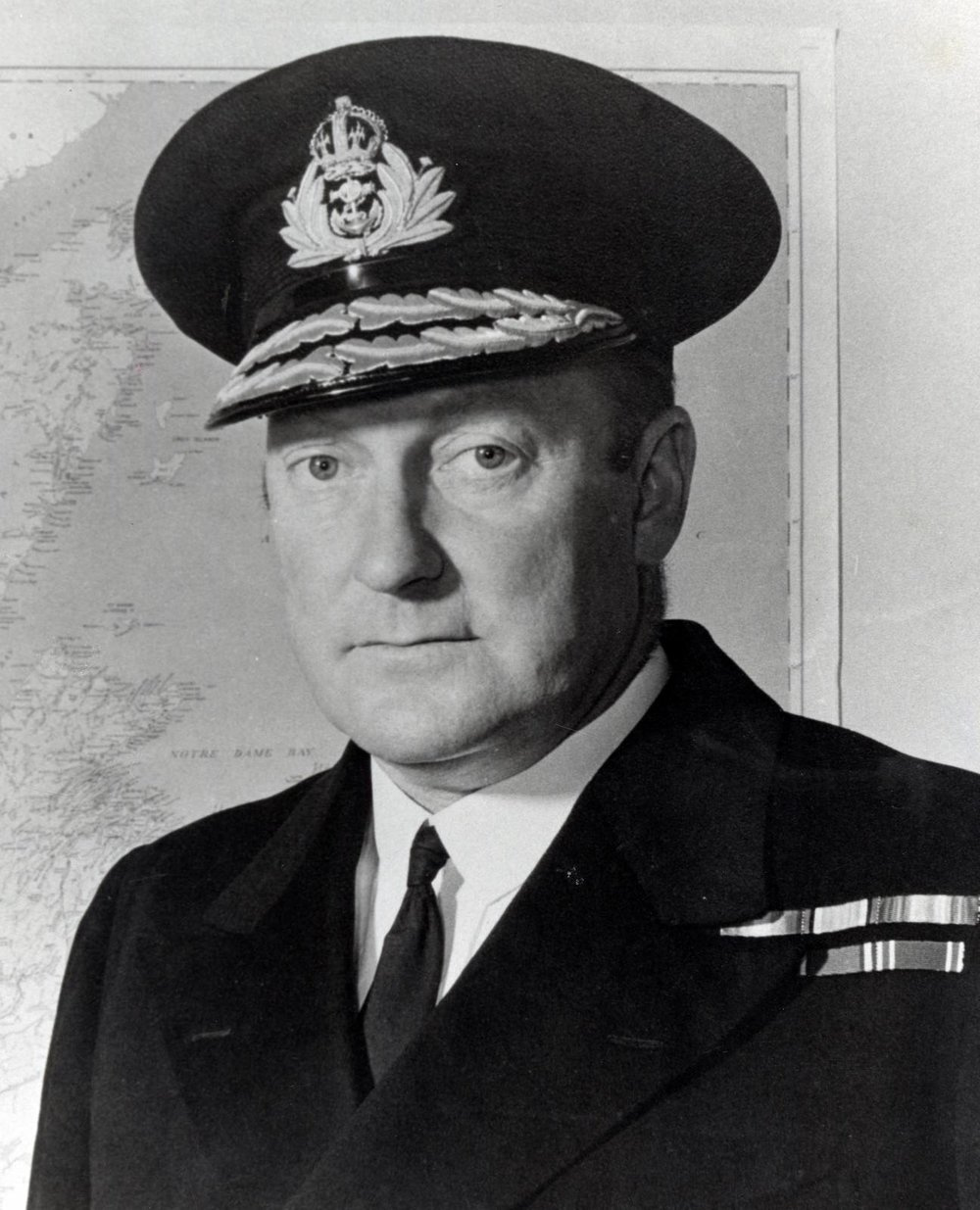
(Rear Admiral L.W. Murray, when he was Flag Officer, Newfoundland)
Murray was above all a competent and confident officer, an excellent ship handler, and an able administrator. Murray’s task in Newfoundland was daunting. Not only were the facilities jury-rigged and totally inadequate; a whole administrative and support staff had to be assembled and adapted to conditions in St John’s. Perhaps because the very long-term existence of NEF, as distinct from the base itself, was an open question in the summer of 1941, the development of its staff was slow. Murray, as CCNF, was charged with overall command of naval operations off Newfoundland. But the initial staff at St John’s in May 1941 was wholly administrative, belonging to the port defence establishment. The first official record of HMCS Avalon, which appeared in the September 1941 Navy Lists, shows little more than Captain Schwerdt’s port-defence and naval-control-of-shipping staffs. Newfoundland Escort Force staff consisted of Murray, his chief of staff Commander R.E.S. Bidwell, RCN, and the commodore’s secretary. A more accurate indication of NEF’s supporting staff by mid-1941 was published in November. By then CCNF had added staff officers of Operations, Intelligence, and Signals and a secretary’s staff. These staffs provided the vital elements of naval operations: the processing and collecting of intelligence, handling of heavy signals traffic, and the organization and management of operational forces.
The actual administration of the escort forces themselves fell to a separate ‘Flotilla’ staff under a " Captain (Destroyers)." Traditionally Captain (D) was a seagoing officer, responsible in all respects, including operational efficiency, for a flotilla of ten to twelve destroyers. administratively the system was applicable to escort forces, but the small size of their ships and the small size of escort groups made it inappropriate for Captains (D) to go to sea. As a result the main staff of escort forces such as NEF remained ashore, while the actual seagoing duties of Captain (D) were passed to the less senior commanders of escort groups.
Captain (D) was crucial to the performance of his forces. Through a staff of specialists he monitored and was ultimately responsible for the efficacy of escort groups, individual ships, and the important warlike functions within each ship. In the early days of NEF the latter problems overwhelmed those of group coordination and the development of and adherence to a suitable tactical doctrine, for which Captain (D) was also responsible. Initially, much-needed specialists in all but a few traditional naval functions were unavailable. During 1941 Captain (D), Newfoundland, had only two, one for gunnery and one for signals. A torpedo officer (who was also in charge of depth charges), was not added until 1942, whilst the key posts of ASW, Radar, and Engineering were not added until 1943. In an ASW escort force the delay in providing specialists to oversee the use of asdic, radar, and depth charges was serious. In the interim, St John’s based escorts had to draw on the expertise of the base ASW and radar officers (both qualified RN officers), whose duties covered maintenance and supervision of port defences as well. Fortunately, these men found time to devote to NEF.
The RCN did what it could, but there were simply not enough qualified personnel to go around. The result was a serious deficiency in Captain (D)'s staff. In the context of a time when things were difficult all around, however, these weaknesses appear comparatively minor. Further, like the escorts themselves, Captain (D)'s initial shortfalls could be expected to diminish with time.
Theoretically at least, Captain (D) was also responsible for the modernization of equipment (in conjunction with local maintenance staff). The limited facilities of St John’s made simple maintenance difficult enough. The port lacked facilities for anything but emergency repairs, supplies of equipment, and even accommodation for extra staffs. Only the Captain (D), Halifax, had an inspection staff for Additions and Alterations (A’s & A’s in naval parlance). St John’s based escorts would turn to Halifax to make their requests. There was nowhere within NEF’s normal operations area where such equipment could even be fitted, and a trip to Halifax, 600 miles away, was hardly satisfactory in a changing tactical environment.
Organizationally and operationally, the NEF was a smaller version of the RN’s Western Approaches Command. The size and composition of escort groups was identical, and the NEF adopted numbers (14-25) following in sequence from those used by WA. Similarly, NEF groups were expected to be more or less permanent in membership in order to foster teamwork, and, as was British practice, sailed under their most senior officer (Senior Officer Escort or SOE). This officer would fulfill the duties of a Captain (D) at sea.
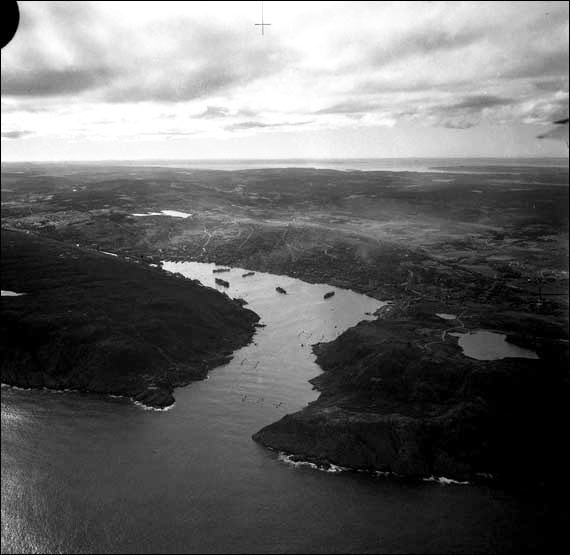
( St John’s Harbour, circa 1942)
CCNFs operational staff acted as the link between the escort forces and the trade and convoy organizations. The control and management of shipping was part of the bureaucratic war. The Commonwealth navies, through their trade divisions and Naval-Control-of-Shipping (NCS) organizations, rationalized and systematized the movement of merchant ships, allowing them to be defended one of two ways. On the basis of intelligence and under the indirect cover of battle fleets, shipping was routed independently along ‘safe’ routes. This form of protection (by far the most prevalent until 1943), was predicated upon existence of British, and later Anglo-American, command of the sea. It was an effective form of defence against the surface raiders, but it would never achieve true success against U-boats, particularly as their numbers grew. The second type of naval defence of shipping was the entire reason the NEF existed.
The organization and sailing of convoys was coordinated by the Admiralty’s worldwide intelligence network, of which Ottawa was the North American centre. The assembling of shipping in convoy port was the responsibility of local NCS staffs working in conjunction with the regional intelligence centre, through which all communication with other regional centres passed. The actual organization of the convoys, issuing code books, charts, special publications, arrangement of pre-sailing conferences, passing out sailing orders, and so forth, was all the work of the NCS. The NCS also handled the Convoy Commodores (mentioned in Part-1 of my posts). His task was similar to that of an admiral commanding a fleet, except his fleet was the motley collection of merchant vessels commanded by an independent breed of seamen.
In large trans-Atlantic convoys the commodore sailed front and centre, usually in a large ship which was well appointed for visual and sound communications with the rest of the convoy and equipped for direct wireless communication with shore authorities. The commodore was also the crucial link between the convoy and its escort. Although the escort commander was ultimately responsible for the safe and timely arrival of the convoy, in practice he and the commodore worked as a team. Depending on the size of the convoy, the commodore was also aided by vice and rear commodores stationed in stern positions on the outer columns of the convoy. Each had his own staff, largely signallers. Interestingly, the majority of convoy signallers in the North Atlantic by 1941 were RCN.
The routing of the convoy was all determined prior to sailing by the RN’s Trade Division, which prescribed a series of point of longitude and latitude through which the convoy was to pass. Minor tactical deviations within a narrow band along the convoy’s main line of advance were permitted by the SOE, but major alterations of course remained the prerogative of shore authorities. The ideal routing was one simple ‘tramline’ along the most direct course between North America and Britain - the great circle route. For a number of reasons tramlines were not feasible until 1943. For the greater portion of the period covered by this study the object of routing remained simple avoidance of the enemy, within the limits of air and sea escorts.
The fast and slow convoy system had undergone some changes by mid-1941. Fast convoys from Halifax were still faster than 9.0 Knots, but ships capable of moving faster than 14.8 knots were routed independently now. Slow convoys from Sydney were ships capable of speeds between 7.5 and 8.9 knots. Their slow speed drew together a feeble and ponderous class of aged tramps, and there was initially no thought of conveying them through the storms of winter. Yet necessity dictated that all merchant shipping below a certain speed be convoyed. For the escorts it was a thankless task. Slow convoys were characteristically unruly. Their ships were prone to belching smoke, breaking down, straggling (falling out of station in the convoy, beyond the protective screen of escorts and accompanying ships), or even romping ahead if stokers happened upon a better-than-average bunker of coal. In the early days slow convoys more often resembled an organized mob than an orderly assemblage of ships, and their slow pace of advance made evasive action in the face of the enemy useless, if not altogether impossible.
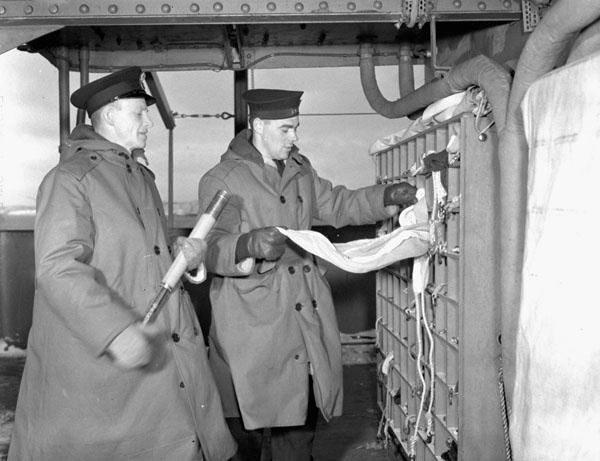
(Signal personnel at the flag locker of the AMC, HMCS Prince David, January 1941)
By the time Murray arrived to take command of NEF it had grown to seven RN and six RCN destroyers, four sloops, and twenty-one corvettes, all but four of them RCN. The Admiralty would have liked even more committed to NEF. Indeed, in early July the Admiralty proposed to NSHQ that Halifax be virtually abandoned as an operational base and that the RCN’s main effort be concentrated a St John’s. Naval Service HQ might have expected grander British plans for St John’s when the Admiralty recommended that Commodore Murray command NEF instead of the RCN’s initial choice, Commander Mainguy. For practical reasons, however, concentrating the entire fleet at St John’s was impossible. In the summer of 1941 there were not enough facilities to support NEF, let alone the RCN’s whole expansion program, and it would be a long time before this situation was reversed. The Naval Council did not debate long before the idea was dismissed as impractical. Nonetheless, subtle British pressure to increase the RCN’s commitment to St John’s was continued, in large part because the RN wanted to eliminate its involvement in escort operations in the Western Atlantic. In August, for example, the Admiralty advised the RCN that it preferred to deal with only one operational authority in the Western Atlantic, CCNF. The pressure, in combination with a serious German assault on convoys in NEF’s area by the late summer, proved successful. Despite growing US involvement in convoy operations in the Western Atlantic, fully three-quarters of the RCN’s disposable strength was assigned to NEF by the end of the year. In spring of 1941, however, the RCN was unprepared to make such large-scale commitments.
One week after Murray assumed his post as CCNF, NEF fought its first convoy battle. Ironically, the confrontation was brought about by the increasing effectiveness of Allied convoy routing as a result of the penetration of the U-boat ciphers in May. Excellent evasive routing so reduced the incidence of interception that the U-boat command, out of frustration, broke up its patrol lines and scattered U-boats in loose formation. This made accurate plotting by Allied intelligence much more difficult and consequently made evasive routing less precise.
The first action against enemy submarines for the NEF was as follows. On the 23rd of June, HX-133, fifty-eight ships escorted by the destroyer Ottawa and three corvettes, Chambly, Collingwood, and Orillia, was sighted by U-203. The U-boat was given permission to attack on the night of 23-24 June, and she easily penetrated the screen and sank one ship. The Senior Officer, Captain E.R. Mainguy (aboard Ottawa), found it impossible to coordinate the escort either in defence or in a search for the assailant because the Canadian corvettes were not fitted with radio telephones and their wireless sets were inadequate. In this first attack only Chambly received any signals from Ottawa, and she only got about half of them. Visual signalling was equally bad. When, on the 26th, Ottawa attacked a contact and two corvettes came to her assistance, Mainguy instructed the latter to stay behind and keep the U-boat down whilst the destroyer re-joined the convoy. The message, sent by light, was only partially received, and the corvettes, unable to pierce the inky darkness with the smaller signal lights, could not obtain a repeat and broke off the action. The escort was eventually heavily reinforced by British ships, and although HX-133 lost six ships, the RN escorts sank two U-boats. Canadian problems in the early going were lamentable, but hardly unexpected. As Joseph Schull, the RCN’s official historian, concluded, ‘no one could have expected it to be otherwise.’
In the meantime, the stern criticism of Captain (D) Greenock regarding the Canadian corvettes reached NSHQ, accompanied by a letter from Captain C.R.H. Taylor, RCN, who had succeeded Murray in London as CCCS. Taylor noted that the poor state of readiness of the corvettes, once again, stemmed from the fact that the Canadians had only ever sent them across with passage crews. Deficiencies could not be made up from the RCN’s UK manning pool since most of the men who were committed to it were in fact still aboard the ships. Taylor also noted that the poor quality of officers, especially COs, had been pointed out in April and that they would never have been assigned if the ships had commissioned permanently. It was heartening to note, however, that Hepatic, Trillium, and Windflower, through remedial work and extreme effort, were worked up to 'a state of efficiency which the Commodore Western Isles reported as surpassing many RN corvettes.
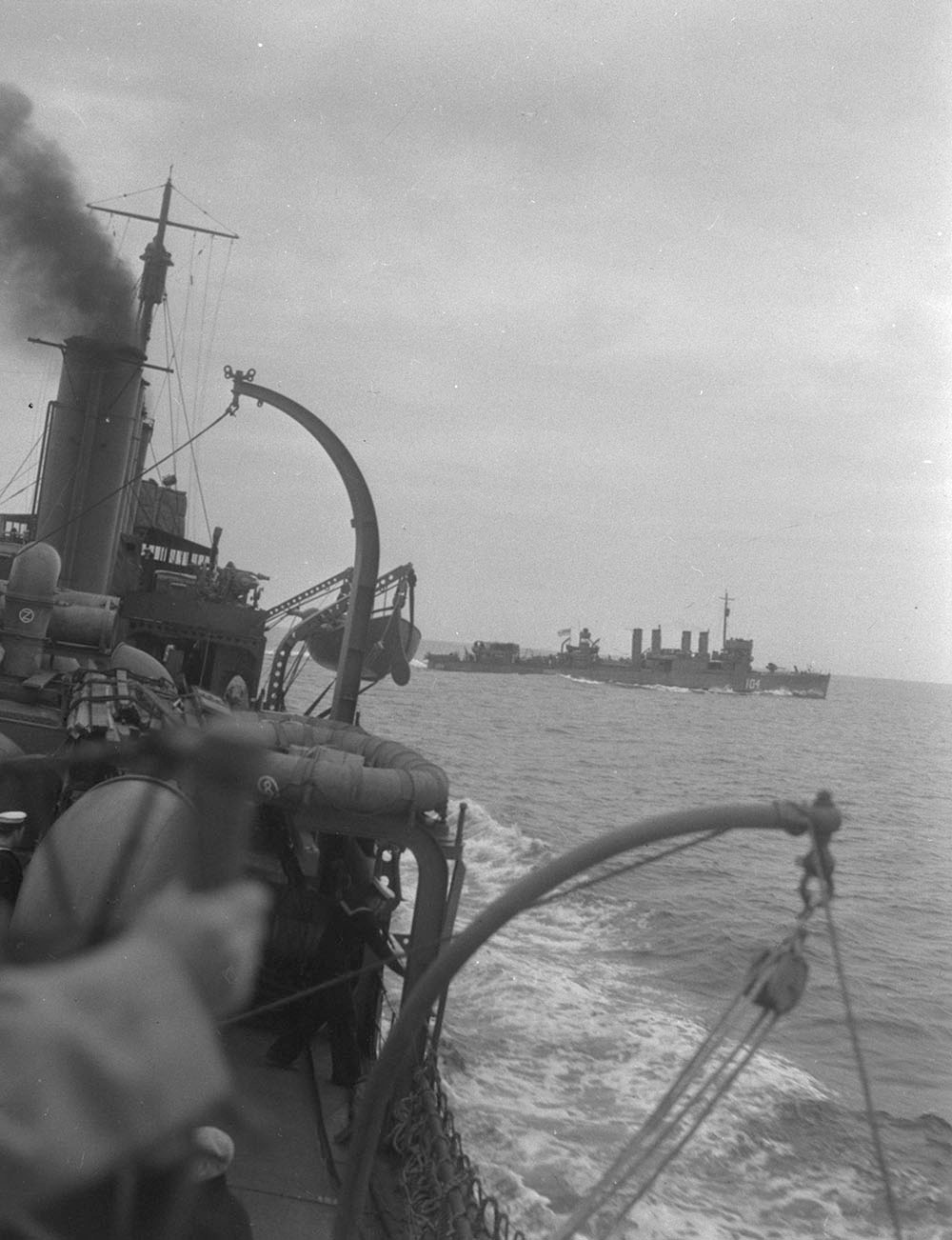
(A picture of HMCS Annapolis, taken from HMCS Hamilton,30 Aug 1941.)
Naval Service HQ was therefore well braced when a follow-up letter from the Admiralty arrived several days later. The letter took a conciliatory view of Canadian difficulties, noting that these seemed to be ‘essentially similar to those occasionally experienced with the RN corvettes and trawlers.’ The Admiralty recommended fixing these issues using the same three methods that the RN used. If the officers and men were competent and responsive, simply prolonging the length of work-up usually sufficed. If the officers were incompetent or otherwise unsatisfactory, they could be replaced by new ones drawn from a manning pool. Similarly, inefficient or unsuitable key ratings could be replaced by men drawn from a pool maintained for this purpose. In its concluding remarks the letter cautioned that corvettes commissioning and working up in Canada were likely to display a wide variation in efficiency, and warned that at this point, with ships stretched to provide continuous ASW escort in the North Atlantic, ‘no reduction in individual efficiency can be safely accepted.’
While the Admiralty clearly felt that it was offering the RCN a workable set of solutions, the suggestions contained few alternatives for the Canadians. In sum, the RCN was hard pressed just to find men with enough basic training in order to get corvettes to sea. Producing a surplus of specialists, of any kind, was out of the question. Nelles, in his draft reply to the Admiralty, pointed out that all experienced officers and men were already committed either to new ships or to the new RCN work-up establishment, HMCS Sambro, at Halifax. Future prospects looked equally grim. Spare HSD ratings (the highest level of asidc operator, of which there was to be one per corvette) would not be available until the spring of 1942, a prognosis even Nelles considered optimistic. And no trained RCN commanding officers or first lieutenants could be spared for some time to come. In short, a pool of qualified and disposable personnel was out of the question. If the RN wanted to loan experienced personnel until they could be replaced by the RCN, such help would be ‘greatly appreciated.’ The only other options were prolonged work-ups or some form of ongoing training. Aside from that, Canadian escorts had to make do. RCN escorts sent to work up at Tobermory not only resulted in ‘much excellent training being lost’; it did little to enhance the RCN’s already tattered image within the parent service.
Although reports from both sides of the Atlantic indicated that the expansion fleet was badly in need of training and direction, its future looked bright in the summer of 1941. Corvettes operating from Sydney and Halifax as part of the Canadian local escort held up remarkably well to operations in the calmer months. A sampling of escorts based at Sydney in the months of August and September reveals startling statistics on the small amount of sea and out-of-service time logged by the new ships. Considerably less than half of their days were spent at sea, and this represented only about 56 percent of their seaworthy time. With so much time alongside, ships’ companies were able to keep up with teething problems. In the ships in question all time out of service was devoted to boiler cleaning.
Later, as operations crowded available time and spare hands crowded the mess decks to provide extra watches for longer voyages, the shorter period became routine. But it is significant that until the fall of 1941 the corvette fleet enjoyed considerable slack, in which it could make good its defects. The easy routine extended to the NEF as well and offered an opportunity to improve on the operational efficiency of escorts already committed to convoy duties. ‘As the force is now organized,’ Captain E.B.K. Stevens, RN, Captain (D), Newfoundland, wrote in early September, ‘there is ample time for training ships, having due regard for necessary rest periods between convoy cycles.’ It would be a year and a half, or more, before the same could be said again. Moreover, when the Canadian escorts did have slack time, the dearth of training equipment at St John’s was, as Stevens reported, ‘a beggar’s portion’; one wholly inadequate target borrowed from the United States Army and one MTU (mobile ASW training unit) bus suitable for training destroyers (although corvette crews could be and were trained on it).
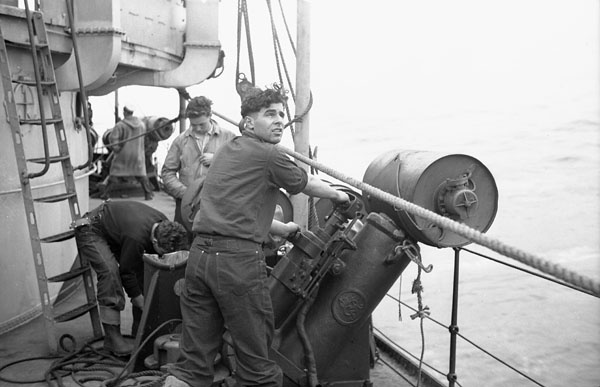
( Crewmen aboard HMCS Saguenay load depth charges into the throwers during an attack on a U-boat, 30th October 1941.)
Captain (D)'s concern for the languishing advance to full efficiency arose from recent gunnery exercises off St John’s. ‘It is noticeable,’ NEF’s gunnery officer reported. ‘that everyone from the First Lt., who is Gunnery Control Officer, downwards put their fingers to their ears each time the gun fired.’ Not surprisingly, this prevented the ship’s gunnery officer from observing the fall of the shot, since he could not possibly use his glasses with his hands thus employed. In addition, some of the guns crews were startled by the firing, and all of this contributed to a deplorable rate of three rounds per minute. Captain (D) dryly concluded that ‘At present most escorts are equipped with one weapon of approximate precision, the ram.’ And so it remained for quite some time.
What NEF really needed, of course , was a proper training staff, hard and fast minimum standards for efficiency, the will to adhere to them, and improved training equipment. A tame submarine would have been a distinct advantage, but by the time L27, the submarine assigned to NEF by Western Approaches Command, arrived from Britain later in the fall, there was no time set aside for training. Throughout 1941 only hesitant and largely unsuccessful attempts were made to rectify this situation. In August Prentice obtained permission from Murray to establish a training group for newly commissioned ships arriving from Halifax. The crews of these were found to be totally ‘inexperienced and almost completely untrained.’ Unfortunately, as with other such attempts, Prentice’s first training group was stillborn because of increased operational demands at the end of the summer. So long as the training establishment at Halifax produced warships of such questionable quality, operations in the mid-ocean suffered, and it would be some time before the home establishments switched their emphasis from quantity to quality.
Relief for the struggling escorts of NEF was in the offing from two directions as summer gave way to autumn. By the end of August 1941 nearly fifty new corvettes were in commission, including those taken over from the RN. More were ready, at the rate of five ships to six per month, before the end of the year. With the men, the ships, and a little time and experience, the nightmare of jamming two years of expansion into one would be ended. This optimistic view was enhanced by the increased involvement of the USN in NEF’s theatre of operations and by the prospect that many of its responsibilities would be passed to the Americans.
The Americans had hardly been passive bystanders in the unfolding battle for the North Atlantic communications. The westward expansion of the war threatened to bring an essentially European conflict to the Western Hemisphere. Certainly, it disrupted normal trade patterns. With the establishment of American bases in Newfoundland in late 1940 that island became for the US what it was already for Canada, the first bastion of defence. But neither the US president, nor American service chiefs were content to rest on the Monroe Doctrine. Moreover, aside from the purely defensive character of US involvement in Newfoundland, the Americans made an enormous moral, financial, and industrial commitment to the free movement of trade to Britain with the announcement of lend-lease in March 1941. A natural corollary to lend-lease was what Churchill called ‘constructive non-belligerency,’ the American protection of US trade with Britain. While Britain would clearly have liked a more rapid involvement of the US in the Atlantic battle, American public opinion would only stand so much manipulation. Therefore, it was not until August that Roosevelt felt confident enough to meet Churchill and work out the details of American participation in the defence of shipping.
A great deal has been written about Roosevelt’s and Churchill’s historic meeting at Placentia Bay, Newfoundland, in August 1941. Here it is only important to note how the agreements directly affected the conduct and planning of RCN operations in the North Atlantic. The British and Americans decided, that strategic direction and control of the Western Atlantic would pass to the US as per ABC 1. Convoy-escort operations west of MOMP (Mid-Ocean Meeting Point) became the responsibility of the USN’s Support Force (soon redesignated Task Force Four), with its advanced base at Argentia, Newfoundland.